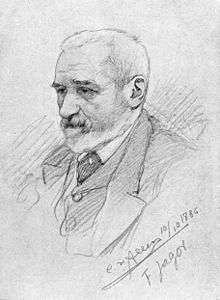Fedor Jagor
Andreas Fedor Jagor (30 November 1816 – 11 February 1900) was a German ethnologist, naturalist and explorer who traveled throughout Asia in the second half of the 19th century collecting for Berlin museums.[1][2]
Fedor Jagor | |
|---|---|
 | |
| Born | 30 November 1816 |
| Died | 11 February 1900 (aged 83) |
| Resting place | Southwest Cemetery in Stahnsdorf |
| Nationality | German |
| Occupation | Ethnologist, naturalist and explorer |
Life and work
Fedor Jagor dealt with ethnography inspired by a visit to Paris. On behalf of the Museum für Naturkunde (Museum of Natural History) in Berlin, he traveled extensively to South and Southeast Asia collecting for the museum. From 1859 to 1861, he was in India, East Asia and the Pacific Islands. He stayed on the island of Java and the rest of the Indonesian archipelago from 1873 to 1876 and from 1890 to 1893.[1]
Since 1869, Jagor was a member of the Berlin Society for Anthropology, Ethnology and Prehistory (Berliner Gesellschaft für Anthropologie, Ethnologie und Urgeschichte), and on January 9, 1879 he became a member of the German Academy of Sciences Leopoldina.[1]
Jagor had an extensive correspondence with Rudolf Virchow and held his travel experiences and observations established in several books. He bequeathed his ethnographic collections to the Ethnological Museum of Berlin. His fortune and art collection were donated to the city of Berlin. His tomb is located after the reburial at the Southwest Cemetery of Berlin in Stahnsdorf (Südwestkirchhof Stahnsdorf).[1]
Writings (selection)
- "Singapore, Malacca, Java: Travel Sketches" Singapore, Malacca, Java: Reiseskizzen. J. Springer, Berlin 1866
- Travels in the Philippines. London: Chapman and Hall. 1875.
- "East Indian trade with regard to the European labor market" Ostindisches Handwerk und Gewerbe mit Rücksicht auf den europäischen Arbeitsmarkt. J. Springer, Berlin 1878
- Jagor, Fedor; et al. (2007). The Former Philippines Through Foreign Eyes (reprint ed.). Echo Library. ISBN 140681542X. Retrieved 24 April 2014.CS1 maint: ref=harv (link)
- Jagor, Fedor; et al. (2007). The Former Philippines Thru Foreign Eyes. Echo Library. ISBN 1406847402. Retrieved 24 April 2014.CS1 maint: ref=harv (link)
Animals named after Jagor
- Jagor's sphenomorphus, Pinoyscincus jagori W. Peters, 1864[2]
- Water snake, Enhydris jagorii W. Peters, 1863[2]
- Greater Musky Fruit Bat, Ptenochirus jagori W. Peters, 1861[3]
- Peters' Trumpet-eared Bat, Phoniscus jagorii W. Peters, 1866[3]
References
- "Fedor Jagor". German Wikipedia. Retrieved on 2012-0316.
- Beolens, Watkins and Grayson (2011). "The Eponym Dictionary of Reptiles". pg. 132. Johns Hopkins University Press, Baltimore. ISBN 978-1-4214-0135-5.
- Beolens, Watkins and Grayson (2009). "The Eponym Dictionary of Mammals". pp. 209-210. Johns Hopkins University Press, Baltimore. ISBN 978-0-8018-9304-9.
External links
- Works by Fedor Jagor at Project Gutenberg
- Works by or about Fedor Jagor at Internet Archive
- Works by or about Fedor Jagor in libraries (WorldCat catalog)